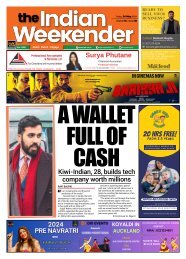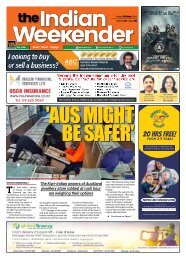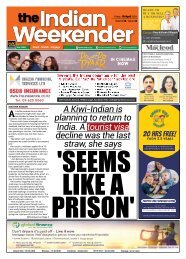The Indian Weekender, 2 April 2021
Weekly Kiwi-Indian publication printed and distributed free every Friday in Auckland, New Zealand
Weekly Kiwi-Indian publication printed and distributed free every Friday in Auckland, New Zealand
You also want an ePaper? Increase the reach of your titles
YUMPU automatically turns print PDFs into web optimized ePapers that Google loves.
14<br />
INDIA<br />
Friday, <strong>April</strong> 2, <strong>2021</strong> <strong>The</strong> <strong>Indian</strong> <strong>Weekender</strong><br />
NEWS in BRIEF<br />
Two <strong>Indian</strong> states vote in test for Modi<br />
Voters in India’s Assam and West Bengal cast their ballots on Saturday<br />
in elections that will indicate how <strong>Indian</strong> Prime Minister Narendra<br />
Modi’s support is holding up after a year of the coronavirus pandemic and<br />
months of protests against his farm reforms.<br />
Modi and Home Minister Amit Shah campaigned energetically for their<br />
Bharatiya Janata Party (BJP) in West Bengal, encouraging defections from<br />
the Trinamool Congress (TMC) party, whose firebrand leader Mamata<br />
Banerjee has been chief minister since 2011.<br />
India’s fourth most populous state, with 90 million people, was for<br />
decades a bastion of communism, and registered a voter turnout of nearly<br />
80% in Saturday’s first phase of voting.<br />
Politicians on the campaign trail often showed scant regard for social<br />
distancing, but as voters queued patiently at polling centres, security<br />
personnel and election workers handed out masks, hand sanitisers and<br />
gloves. Modi was re-elected for a second five-year term in 2019, and his<br />
BJP is pushing to extend its influence beyond the 12 out of 28 states where<br />
it rules alone, and several others where it is part of a ruling alliance – not<br />
least because this would help it to control the upper house of the federal<br />
parliament.<br />
India’s Modi gifts Bangladesh 1.2m doses of<br />
AstraZeneca vaccine<br />
India gave 1.2 million free<br />
doses of the AstraZeneca<br />
coronavirus vaccine to<br />
Bangladesh, its foreign minister<br />
said, as Dhaka urged New Delhi to<br />
maintain a regular supply of shots<br />
to battle the pandemic. <strong>Indian</strong><br />
Prime Minister Narendra Modi made the offering at the end of a two-day<br />
tour of Bangladesh to celebrate its 50th independence anniversary. <strong>The</strong> trip<br />
also marked Modi’s first foreign travel since the outbreak of the pandemic.<br />
Bangladesh signed a deal in November with the Serum Institute of India,<br />
the world’s biggest vaccine maker, for 30 million doses of the AstraZeneca<br />
vaccine. <strong>The</strong> country of more than 160 million people has already received<br />
9 million vaccine doses from Serum. India has also previously gifted<br />
its neighbour 2 million doses of the shot that Serum is producing for<br />
many countries. India has told its international partners that it will<br />
prioritise domestic inoculations over exports of vaccines as it battles a rise<br />
in new infections.<br />
“Bangladesh has requested a regular supply of the remaining vaccines<br />
purchased from the Serum Institute,” the country’s foreign minister A.K.<br />
Abdul Momen said in a televised speech.<br />
India will donate military equipment used<br />
in 1971 for museums<br />
<strong>Indian</strong> Prime Minister Narendra Modi announced that New Delhi will<br />
donate military equipment used the country's in the 1971 Liberation War<br />
to be displayed in museums in Bangladesh.<br />
Modi made the announcement on Saturday in Dhaka on the last day of<br />
his two-day official visit to Bangladesh, which was his first trip abroad after<br />
the onset of the Covid-19 pandemic. On Saturday evening, Modi met his<br />
Bangladeshi counterpart Sheikh Hasina for one-on-one talks at the latter's<br />
office in Dhaka after which the two sides signed five MoUs, inaugurated<br />
and launched eight projects and made 10 announcements. During his visit,<br />
he also laid the foundation stone for a memorial honouring martyrs from the<br />
<strong>Indian</strong> Armed Forces who were killed during the Liberation War.<br />
It will be built at Ashuganj, near Dhaka. This is the first memorial in<br />
Bangldesh exclusively honoring the <strong>Indian</strong> martyrs. Modi arrived in Dhaka<br />
and participated in a gala event commemorating the birth centenary of<br />
Bangabandhu Sheikh Mujibur Rahman, as well as the celebrations marking<br />
golden jubilee of Bangladesh independence.<br />
Parts of India to see deadly heat waves in coming<br />
decades: Study<br />
Limiting warming to 1.5 degrees Celsius will likely reduce the impact of<br />
deadly heat waves by half, but the heat waves will become commonplace<br />
across South Asia, including major crop-producing regions in India -- such<br />
as West Bengal and Uttar Pradesh, says a new study. <strong>The</strong> findings, published<br />
in the journal Geophysical Research Letters, indicated that these deadly heat<br />
waves will likely become more commonplace in the coming decades even if<br />
global warming is limited to 1.5 degrees Celsius.<br />
"Even at 1.5 degrees, South Asia will have serious consequences in<br />
terms of heat stress," said researcher Moetasim Ashfaq from the Oak Ridge<br />
National Laboratory in the US. <strong>The</strong> future looks bad for South Asia, but the<br />
worst can be avoided by containing warming to as low as possible," Ashfaq<br />
added. <strong>The</strong> results differ from a similar study conducted in 2017, which<br />
predicted that heat waves of lethal temperatures will occur in South Asia<br />
toward the end of the 21st century, the researchers said.<br />
<strong>The</strong> researchers suspect the earlier study is too conservative, as deadly<br />
heat waves have already hit the region in the past.<br />
In 2015, large parts of India and Pakistan experienced the fifth<br />
deadliest heat wave in the recorded history, which caused about 3,500<br />
heat-related deaths.<br />
COVID VACCINE:<br />
How many people<br />
has India vaccinated?<br />
More than 55 million doses of coronavirus<br />
vaccines have been administered in India in<br />
what is the world's biggest inoculation drive.<br />
India's Covid caseload had dropped sharply by the time<br />
it began vaccinating people early this year. It was adding<br />
under 15,000 infections daily. But cases began to spike<br />
again in March, largely driven by poor test and trace and<br />
lax safety protocols.<br />
On Thursday, the country reported 59,118 new cases -<br />
the sharpest daily rise since October last year.<br />
Since the pandemic began, India has confirmed more<br />
than 11.7 million cases and over 160,000 deaths. It's the<br />
third-highest number of Covid-19 infections in the world<br />
after the United States.<br />
How is the rollout going?<br />
India launched its vaccination drive on 16 January, but<br />
it was limited to healthcare workers and frontline staff - a<br />
sanitation worker became the first <strong>Indian</strong> to receive the<br />
vaccine.<br />
From 1 March, the eligibility criteria was expanded<br />
to include people over 60 and those who are between 45<br />
and 59 but have other illnesses. <strong>The</strong> government has now<br />
announced that from 1 <strong>April</strong>, the jab will be available to<br />
anyone aged 45 years and above.<br />
<strong>The</strong> country's drugs regulator has given the green light<br />
to two vaccines - one developed by AstraZeneca with<br />
Oxford University (Covishield) and one by<br />
<strong>Indian</strong> firm Bharat Biotech (Covaxin).<br />
Several others candidates are at<br />
different stages of trials.<br />
India also wants to scale<br />
up the drive quickly to stem<br />
the spike in cases in recent<br />
weeks. So it has placed a<br />
temporary hold on all exports<br />
of the Oxford-AstraZeneca<br />
coronavirus vaccine, which<br />
is being made by India's largest<br />
vaccine manufacturer, the Serum<br />
Institute of India (SII). Foreign ministry<br />
sources told the BBC that a spike in cases meant that<br />
demand in the country for the vaccine was likely to pick<br />
up in the coming weeks, and so more doses were needed<br />
for India's own rollout.<br />
Some 190 countries under the World Health<br />
Organisation (WHO)-led Covax scheme will be affected.<br />
India has exported more than 60 million vaccine doses<br />
to 76 countries so far, with majority of these being the<br />
Oxford-AstraZeneca jab.<br />
How many have been vaccinated so far?<br />
More than 55 million doses of coronavirus vaccines<br />
have been administered so far.<br />
On Friday, the government said it administered more<br />
than 2.3 million doses in the last 24 hours.<br />
Nearly 40 million people have received one dose, and<br />
over eight million people have been fully vaccinated<br />
after receiving two doses. For decades now, India has<br />
been running one of the world's largest immunisation<br />
programmes that vaccinates tens of millions and newborns<br />
and pregnant women against various diseases.<br />
So experts believed India was well-prepared for the<br />
challenge. But the uptake has been slow because of<br />
vaccine scepticism as well as lack of awareness among<br />
the poor or in rural areas.<br />
Many of the poor have little information on how to<br />
register themselves and access the vaccine free of cost.<br />
Online registration could be an impediment for those who<br />
don't own phones or use the internet.<br />
"<strong>The</strong>re's very little public health communication for the<br />
poor and the working class regarding the vaccines," says<br />
Radha Khan, an independent consultant working in the<br />
field of gender, governance and social inclusion.<br />
Prime Minister Narendra Modi, who's 70 years old, got<br />
his vaccine shot on 1 March. He was administered a jab of<br />
the indigenously developed Covaxin.<br />
After receiving the jab, he urged people to take the<br />
vaccine when their turn came.<br />
<strong>The</strong> government aims to use up to 500 million doses<br />
to cover 250 million "priority people" by the end of July.<br />
More than 56 million people have registered for the jab<br />
mostly through two government apps. Interestingly, in<br />
some states, more women than men have been vaccinated.<br />
<strong>The</strong> reasons are not clear.<br />
Who is paying for the vaccines?<br />
Vaccination is voluntary. State-run clinics and hospitals<br />
are offering free jabs but people can also pay 250 rupees<br />
($3.4; £2.4) a dose at private facilities to get vaccinated.<br />
<strong>The</strong> government is spending around $5bn for free doses<br />
at state-run clinics, public health centres and hospitals.<br />
It has also bought millions of doses of two approved<br />
vaccines and provided funds to states for their vaccination<br />
programmes.<br />
Have there been 'adverse events' after<br />
vaccination?<br />
Vaccines come with side effects for some people.<br />
India has a 34-year-old surveillance programme<br />
for monitoring such "adverse events" following<br />
immunisation. Experts say a failure to transparently<br />
report adverse effects could easily lead to fearmongering<br />
around vaccines.<br />
Until early February, India reported 8,483<br />
"adverse events" after vaccination. Most of these<br />
events were "minor" - anxiety, vertigo, giddiness,<br />
dizziness, fever, and pain, and all patients had<br />
recovered, the government said.<br />
<strong>The</strong> surveillance programme has examined 412 cases<br />
of "severe adverse events", including 79 deaths after<br />
vaccination until 13 March, according to a senior official.<br />
It found the "deaths happened in cases where the person<br />
had underlying conditions, including heart problems, high<br />
blood pressure and diabetes".


















